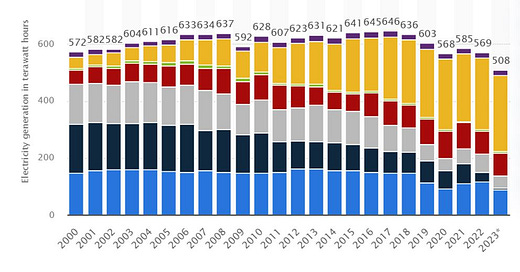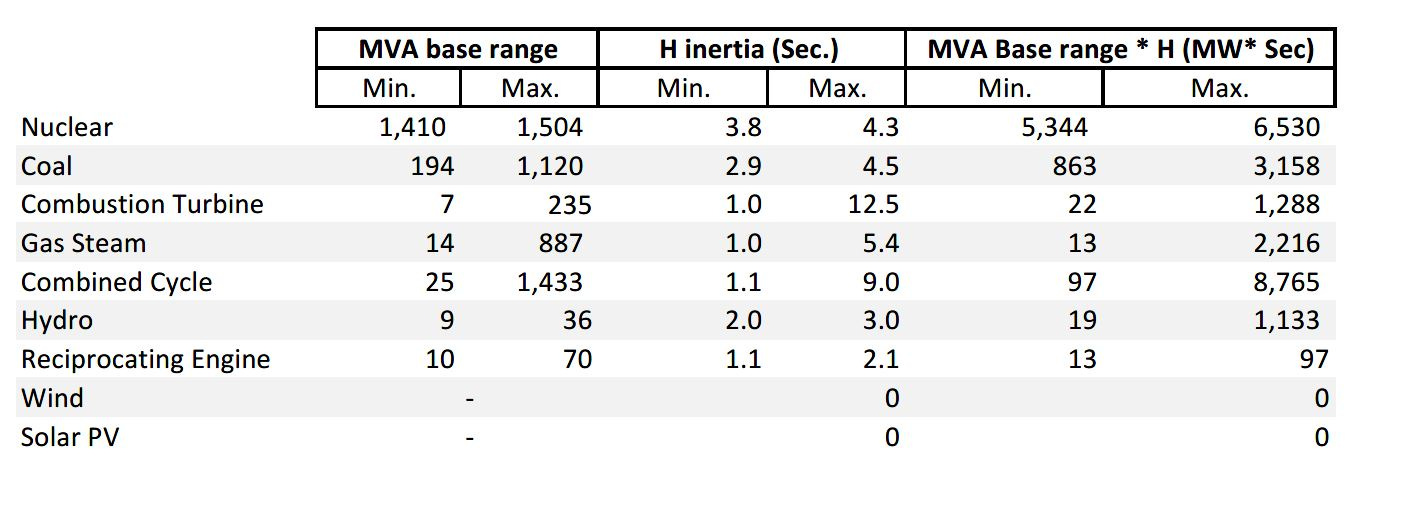Protesting California's Ongoing Nuclear to Coal Transition - Part 2
German deindustrialization follows slashing safe, reliable, cost-effective and zero-pollution nuclear power generation
1. Slashing nuclear and coal imperils German grid stability
Since 2000, Russia and China expanded their political and economic power by pushing for Germany to slash the nation's use of both nuclear power and coal-fired power on dubious environmental grounds. On the other hand, China and Russia's political maneuvering also informed world powers that the increasing sale of Russian natural gas and the sharply accelerating use of coal and natural gas in Communist China was environmentally acceptable. The table below reveals stark nuclear power comparisons between Germany, France, the United States, Communist China, and Russia. This article focuses on Germany's need to restore its nuclear power fleet to grow economically and assure grid stability by a combination of recommissioning and new construction.
Germany and the United States Need to recommission and build new nuclear reactors. (November, 2024 data courtesy the World Nuclear Association)
Californians for Green Nuclear Power (CGNP) gathered a set of articles regarding the Russian political maneuvering since about 2000 to convince Germany to voluntarily abandon their safe and well-maintained nuclear power fleet. See the final section of CGNP's May 8, 2024 objections to the WWGPI at
https://tinyurl.com/WWGPI-Opposed
2. Gross German Generation Since 2000
Germany's DESTATIS provides energy contribution tabulations for Germany's electricity only since 2019. These tabulations fail to show the "big picture" of the changes since 2000. CGNP located a Statista graph that we were able to convert into a tabulation. Charts showing annual gross German nuclear power generation, annual German coal-fired generation, and annual gas-fired generation appear after the overview graph.
Gross Electricity Generation in Germany from 2000 to 2023 TeraWatt-hours (TWh )
https://www.statista.com/statistics/1330065/gross-electricity-generation-by-source-germany/
An electric power grid with sufficient synchronous grid inertia (SGI) remains stable despite significant supply or demand perturbations. Without sufficient synchronous grid inertia, a power grid will suffer cascading blackouts that are difficult to recover from. An introduction to SGI is found in the March 4, 2024 GreenNUKE Substack article, "Why is Grid Inertia Important?" https://greennuke.substack.com/p/why-is-grid-inertia-important
3. Sufficient SGI Assures Grid Stability. For Germany, Nuclear and Coal are Superior.
To obtain a sense of the significant influence of different energy supplies on SGI, the Energy Reliability Council of Texas (ERCOT) provided Table 1 in their 2018 paper about SGI. In 2000, the German electric power grid stability was assured by generous quantities of nuclear and coal-fired generation for sufficient SGI. This is shown in the first two lines of the chart below for ERCOT generators. German nuclear and coal-fired generators were comparable to ERCOT's. Since 2000, Germany invested in very large quantities of solar and wind generation which contribute negligible SGI. The very large quantities are shown in the first Statista graphic. Germany needlessly retired large quantities of nuclear and coal-fired generation. The unfortunate but predictable result is the German power grid now has precarious stability.
Table 1, Inertia: Basic Concepts and Impacts on the ERCOT Grid, April 4, 2018, ERCOT, Austin, Texas. https://www.ercot.com/files/docs/2018/04/04/Inertia_Basic_Concepts_Impacts_On_ERCOT_v0.pdf
4. Germany needs to restore its nuclear generation fleet
Here's the annual generation trend chart for German nuclear power since 2000.
In 2000, German nuclear power plants generated about 170 TWh (approximately equal to the annual electric power production of ten Diablo Canyon Power Plants (DCPPs.)) By 2023, the German annual nuclear power production was almost zero.
5. Germany needs to shore up its coal-fired generation fleet
The annual trend table for coal-fired power is almost as grim.
In 2000, Germany's coal-fired power plants generated 291 TWh of electricity. By 2023, the annual coal-fired power production dwindled to 131 TWh, about 45% of the year 2000 value.
6. Germany's natural gas-fired generation fleet is challenged by an unreliable supply.
A Gazprom Caution Sign for Europe.
German natural gas-fired generation was unable to make up for the diminution in nuclear and coal-fired generation. In 2000, gas generation was a mere 49 TWh. By 2023, gas-fired generation had only increased about 31 TWh to 80 TWh. Until Germany is able to acquire a reliable natural gas supply sufficient to meet primary energy needs of both businesses and residences AND meet the energy needs for generation, expansion of its gas-fired generation fleet is a risky proposition.
7. German Electricity Imports are Meager.
Unlike the case of California which receives substantial power from nearby states, Germany receives considerably less power. California typically consumes about 300 TWh per year with about 1/3 or 100 TWh from imports. The German trade association BDEW provided information regarding German power imports as part of their 2023 annual report showing approximately 44.3 TWh received from ten nearby nations. Here is a slide from that report with some English translations.
Germany exported some of the power it received from the 10 nations sending it power. Since Germany needed dispatchable high-quality power from nuclear and coal, it likely retained that 14.8 TWh share in 2023 while exporting the remaining 29.5 TWh of low-quality nondispatchable solar and wind power to other nations. Like Germany, California also exports large amounts of surplus solar and wind generation that it does not require. California ratepayers must pay adjoining states to accept their low-quality nondispatchable solar and wind power.
Unlike Germany, California is further disadvantaged by recent legislation that created a California specific legal euphemism, "Unspecified Power." This legislation allows large amounts coal-fired power to be imported to the environmentally-conscious state of California from states such as Wyoming - and deem the out-of-state power to have considerably less air and water pollution associated with the imported power. See "The Case of the Missing 40 MMT/year of California Electricity Sector Emissions
- The coal train needed to generate those emissions would be 1,159 miles long," July 15, 2024, GreenNUKE Substack.
https://greennuke.substack.com/p/the-case-of-the-missing-40-mmtyear
8. BDEW's 2023 German Electricity Trends.
As a highlight of BDEW's annual report, they highlighted ten key trends in 2023. They are shown below. The first point is highly significant and bolded for emphasis.
https://www.bdew.de/service/publikationen/jahresbericht-energieversorgung/
The Energy Year 2023 – the 10 most important points:
1. Record low in primary energy consumption – main causes: high energy prices and weak economy
2. Consumption decline of 4 to 6% for all grid-based energies (natural gas, electricity, district heating)
3. Natural gas supply continuously secured through well-filled storage facilities and LNG supply
4. The USA is the main supplier of LNG with 83%
5. Electricity generation fell by 10.5%
6. For the first time, more than 50% of electricity comes from renewable energies – record expansion of photovoltaics
7. Electricity exchange: for the first time in 20 years, import surplus – a good half from renewables, around a quarter each from nuclear energy and conventional energies
8. CO2 emissions from the energy industry have fallen by 22% compared to 2022, and
the reduction compared to 1990 is now 57%
9. Further proportional increase in heating with electric heat pumps in the new building market – with overall weak construction activity
10. End-customer prices for electricity and gas in households have fallen continuously since the beginning of 2023 after peaking
9. Eugyppius and Robert Bryce's Observations Regarding German Electricity.
While BDEW highlighted these German energy trends earlier in 2024, several energy analysts recently raised additional criticisms of German politics and energy policies. An author with the pseudonym Eugyppius wrote an article on November 9, 2024 titled, " How the German government collapsed and what will happen now"
This article describes how the German "Ampel" (traffic light) coalition government just collapsed as a consequence of the huge expense and poor economic outcomes of the German "Energiewende." The complete text of this article is found in the supplemental materials for this article at CGNP's website.
The next day, veteran U.S. energy reporter Robert Bryce wrote, "Germany Is Dunkelf**ked (In 5 Charts) - Its coalition government, wind energy output, and industrial base are all collapsing." November 10, 2024
This article is also available at the CGNP website.
11. The Energiewende is pure propaganda.
As further confirmation of the concerns raised in the article you are reading, the political advocacy of German Greens is partially funded via German taxpayers through the Heinrich Böll Foundation (hbs.) Here's an anti-nuclear power example post: "Renewables replace nuclear and lower emissions simultaneously," Craig Morris, 20 Nov 2019, Energy Transition - The Global Energiewende blog. https://energytransition.org/2019/11/renewables-replace-nuclear-and-lower-emissions-simultaneously/ (This hbs article is pure propaganda.) The Energiewende blog is an initiative of the Heinrich Böll Foundation. © 2012 - 2024. The hbs has elegant offices in Berlin. The hbs also has offices in the West Bank of Palestine, Moscow, Russia, Beijing, China, and Washington, DC. Many of the policies of the hbs are socialist policies in "green" garb.
12. If Germany had spent about half of the sum it wasted on the Energiewende since 2002 on nuclear power, Germany's air and water pollution would be far less now - and their power grid would be reliable and durable.
In addition to the five informative charts, Robert Bryce's article included this important paragraph:
In September, a study published in the International Journal of Sustainable Energy estimated that between 2002 and 2022, the energiewende cost Germany $746 billion. More than half of that sum was spent on alt-energy production and distribution, and the remainder on subsidies. The study concluded that if Germany had spent about half that massive sum on nuclear energy, it would have achieved greater emissions reductions than it did by chasing the mirage of alt-energy.
After downloading this new article, CGNP contacted the author, Jan Emblemsvåg, Ph.D. a professor at NTNU in Ålesund, Norway. Professor Emblemsvåg generously supplied his related article and several informative charts showing the expensive consequences of Germany's policy choice to end nuclear generation. He later supplied a rebuttal to objections raised by the Fraunhofer Institute. These articles and charts are available within the supplemental materials at the CGNP website.
Anticipating Professor Emblemsvåg's criticisms of solar and wind generation in 2011, the eminent scientists, engineers, and economists at the California Council on Science and Technology, a nonprofit which serves to advise the California government regarding science and technology matters, were asked by the California Energy Commission, "What was the most cost-effective way to decarbonize the California power grid?" Their answer was to build about 30 new nuclear power plants. https://tinyurl.com/CCST-Nuclear-1 https://tinyurl.com/CCST-Nuclear-2 A 3 1//2 page summary by the late Nobel laureate Burton Richter, Ph.D. is here: https://ccst.us/wp-content/uploads/071511richter.pdf
13. Conclusion.
The logical and economical first step for Germany to restart its ailing economy is to recommission as many of its nuclear power plants as quickly as possible. There is growing political support for this action. "German opposition MPs propose checking feasibility of restarting nuclear plants," 05 Nov 2024, 13:19 Benjamin Wehrmann | Germany, Clean Energy Wire.
https://www.cleanenergywire.org/news/german-opposition-mps-propose-checking-feasibility-restarting-nuclear-plants
With so many recent developments, GreenNUKE anticipates updates to this article will be forthcoming.
















I can tell you're winning in the court of public opinion when I see US expats in drought-plagued Ecuador which has major hydroelectric generation shortages discussing nuclear energy and SMR's in expat groups.
What are the chances you can win against Berkshire Hathaway, with there fleet of lawyers and lobbyists?